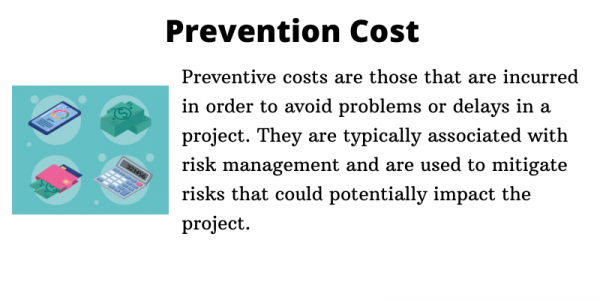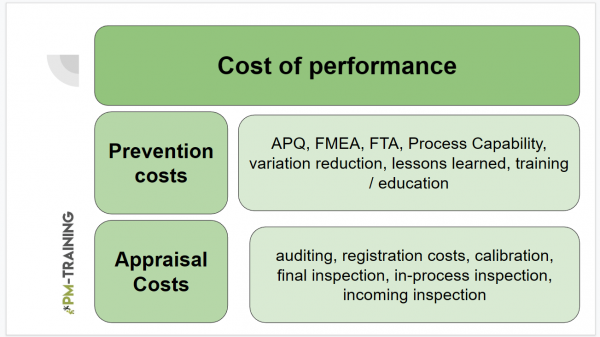Prevention costs are those that are incurred in order to avoid problems or delays in a project. They are typically associated with risk management and are used to mitigate risks that could potentially impact the project. While preventive costs can add to the overall budget of a project, they can also save money in the long run by avoiding costly delays and problems. Therefore, it is important to consider preventive costs when planning a project.
Project quality management is the process of ensuring that the quality of the project meets the requirements of the customer. This includes all aspects of the project, from the initial planning stages to the delivery of the final product.
There are various quality management tools and techniques that can be used to improve the quality of a project. One of these is preventive cost.
As a project manager, you’re always looking for ways to improve the quality of your project while also reducing costs.
One important cost to consider is the cost of quality, which is the money spent to prevent or fix problems.
Every organization seeks to optimize its project quality management processes and achieve the delivery of defect-free products or services within the stipulated time and budget. Ultimately, an important aspect of quality management is the cost of quality, which is the cost incurred to prevent, find, and fix defects.

Prevention Cost Formula
In order to calculate prevention costs, you must first identify the risks associated with your project.
As a project manager, one of your key responsibilities is to ensure that your project stays on budget. One way to do this is to calculate the prevention costs for your project. Prevention costs are the costs associated with preventing problems from occurring in the first place.
One of the prevention costs formulas is:
Prevention Costs = (Number of potential problems x Cost to fix each problem) x (Probability of each problem occurring)
Calculating Prevention Cost
- Let’s say you’re managing a project with a budget of $1,000,000. You’ve identified 10 potential problems that could occur, and each problem would cost $100,000 to fix. The probability of each problem occurring is 20%.
Using the formula, we can calculate the prevention costs for this project as follows:
- Prevention Costs = (10 x $100,000) x (20%)
- Prevention Costs = $2,000,000
As you can see, the prevention costs for this project are $2,000,000. This means that you should
Prevention costs can be difficult to calculate, but they are an important part of any project management budget. By including prevention costs in your budget, you can help to ensure that your project stays on track and that potential problems are dealt
How To Reduce Prevention Costs?
Prevention costs are those that are incurred to keep the project on track and avoid problems. They are often seen as necessary evils, but they don’t have to be. By taking a few simple steps, you can reduce the prevention costs in your project and improve your bottom line.
Allocate Competent Resources
Allocate competent resources during the project initiation phase. This ensures that you have the right people working on the project from the start and that they are familiar with the project’s goals and objectives.
Track Spending
Track forecasted vs. actual spending to control project costs. This helps you to identify areas where you are overspending and makes it easier to adjust your budget accordingly.
Use Job Strategy
You can boost productivity through a job rotation strategy. This involves rotating employees through different tasks so that they are better able to understand the project as a whole and identify potential problems. By taking these steps, you can reduce the prevention costs in your project and improve your bottom line.

Types of Preventive Costs
There are two main types of preventive costs:
Insurance
Insurance costs are those that are associated with protection against future risks.
- For example, a business might purchase insurance to protect against the possibility of a natural disaster.
Upkeep costs
Upkeep costs are those that are associated with maintaining existing assets and infrastructure.
- For example, a business might invest in routine maintenance to avoid potential problems with its machinery.
Also, another important type to consider but not essential are the ongoing costs:
Ongoing costs: These are costs that are incurred throughout the life of a project. They are often used to pay for quality control measures or to train staff on proper procedures.
Examples of Preventive Costs
As in project management, preventive measures are often taken in order to avoid cost overruns, schedule delays, and other potential problems. Some examples of preventive costs to avoid internal failure cost in project management include:
- Hiring a Project Manager:
A seasoned project manager is a proactive step that helps prevent cost overruns and schedule delays. A competent project manager has the experience, leadership skills, and technical knowledge to effectively manage projects and anticipate potential issues. They work closely with project teams to ensure project goals are met, timelines are kept, and risks are minimized. The investment in a project manager is a preventive cost that pays off by ensuring the success of the project. - Risk Assessment:
Conducting a comprehensive risk assessment is an important preventive cost in project management. It involves identifying potential risks and their impacts on the project. The goal of a risk assessment is to identify potential issues before they occur and develop contingency plans to minimize the impact of risks on the project. Regular risk assessments help project managers stay ahead of potential issues and ensure the project is protected from costly delays or unexpected events. - Contingency Plans:
Contingency plans are a crucial component of project management and a preventive cost. They provide a backup plan for unexpected events and provide project managers with a roadmap for dealing with potential risks. A well-prepared contingency plan can help minimize the impact of unexpected events on the project timeline and budget. - Staff Training:
Providing training to project staff is a preventive cost that helps ensure the project is completed with the highest quality. Training covers the best practices, techniques, and procedures for avoiding potential problems and ensuring project success. By investing in staff training, project managers can increase the efficiency of the project team, avoid problems and ensure project success. - Progress Reviews:
Regular progress reviews are an important preventive cost in project management. They provide project managers with an opportunity to monitor the project’s progress, identify potential issues, and address them before they become significant problems. Progress reviews also help project managers stay informed of project changes, identify potential risks and develop contingency plans to mitigate risks. - Insurance:
Insurance is a preventive cost that protects the project from future risks such as natural disasters, accidents, or other events that could impact the project. Insurance helps project managers ensure the project is protected against potential losses and provides peace of mind that the project is protected in the event of unforeseen circumstances. - Upkeep Costs:
Upkeep costs are preventive costs that are associated with maintaining existing assets and infrastructure. This can include routine maintenance or repairs to avoid potential problems with machinery or equipment. By investing in upkeep costs, a project can avoid costly problems and stay on track.
FAQ
What are Preventive Costs?
Preventive cost is a crucial element of project quality management. By investing in prevention, you can avoid the cost of defects, rework, and downtime.
Why is Preventive Cost Important?
Preventive cost is important because it can help to avoid the cost of poor quality. By investing in prevention, you can avoid the cost of defects, rework, and downtime. Preventive cost is an important part of quality management because it can help to ensure that the project meets the requirements of the customer.
How to reduce prevention costs?
One way is to allocate competent resources during the project initiation phase. This ensures that the project is executed smoothly and efficiently from the start. Additionally, tracking forecasted vs. actual spending can help to control project costs. Finally, boosting productivity through a job rotation strategy can also help to reduce prevention costs.
What are the main benefits of preventing costs?
The benefits of effective preventive cost include avoiding the cost of poor quality, improving the quality of the project and generally meeting the requirements of the customer.
